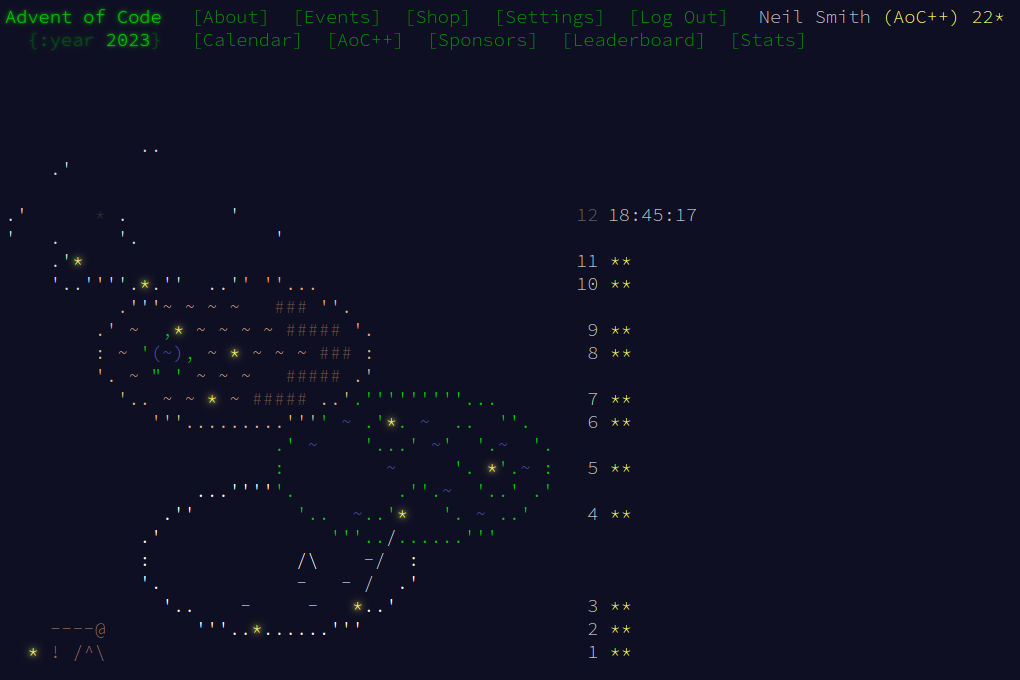Day 11 was a much smaller problem than day 10's solution.
My first consequential decision was how to represent the map of galaxies. There are two main choices: the sparse representation, where I just record the points that matter (in a Set), and the densse representation, where I record every possible point (in an Array). As there were only a few points, and I was going to be expanding the bounds of the area, I decided on the sparse representation.
In this case, the Galaxies are the Set of Positions.
type Position = V2 Int -- r, c
type Galaxies = S.Set PositionReading the input is a case of going through the input position-by-position and recording a point if it's the right character.
mkGalaxies :: String -> Galaxies
mkGalaxies text = S.fromList [ V2 r c | r <- [0..maxR], c <- [0..maxC]
, rows !! r !! c == '#'
]
where rows = lines text
maxR = length rows - 1
maxC = (length $ head rows) - 1Expansion
Luckily, expanding the rows and columns is independent. I expand the rows first, then expand the columns on the result of that. I'll show only how to do the rows: the columns is exactly the same, only acting on columns not rows.
Building from the bottom up, I can find all the points on a row. A row is empty if it has no points, and I use that to find all the empty rows.
emptyRows :: Galaxies -> [Int]
emptyRows galaxies = [ r | r <- [0..r1] , S.null $ onRow galaxies r ]
where r1 = S.findMax $ S.map (\(V2 r _) -> r) galaxies
onRow :: Galaxies -> Int -> Galaxies
onRow galaxies r = S.filter (\(V2 r' _) -> r == r') galaxiesI expand the rows by starting from the end of the list of empty rows. For each row I expand, I add the scale factor to all points below that row. This pattern of accumulating changes is another fold, this time a foldr to work from the end.
expandRows :: Galaxies -> [Int] -> Int -> Galaxies
expandRows galaxies expansions scale = foldr (shiftRows scale) galaxies expansions
shiftRows :: Int -> Int -> Galaxies -> Galaxies
shiftRows scale n galaxies = S.union small large'
where (small, large) = S.partition (\(V2 r _) -> r < n) galaxies
large' = S.map (^+^ (V2 (scale - 1) 0)) largeNote that the scale is the number rows that replace each empty row, so I add scale - 1 additional rows.
(I could possibly fiddle with these functions to parameterise them over the dimension I'm using, but I think it's fine for this small example and just two dimensions.)
Distances
The distance is just the Manhattan distance, the L1 norm. I find the distances between all pairs of points with two nested folds. The outer fold uses an accumulator of the processed points and the running-total distance. As a new point is brought in, the inner fold finds the distance from the new point to all the already-seen points.
distance :: Position -> Position -> Int
distance g1 g2 = abs dr + abs dc
where (V2 dr dc) = g1 ^-^ g2
allDistances :: Galaxies -> Int
allDistances gs = snd $ S.foldl' addGalaxy (S.empty, 0) gs
where addGalaxy (seen, d) new =
(S.insert new seen, S.foldl' (addDist new) d seen)
addDist g1 d g2 = d + distance g1 g2Solution
And that's it!
part1, part2 :: Galaxies -> Int
part1 = allDistances . expandGalaxies 2
part2 = allDistances . expandGalaxies 10e6But I did get caught by an off-by-one error in the scale for a few minutes. Thanks, Eric, for the good examples!
Code
You can get the code from my locally-hosted Git repo, or from Gitlab.

